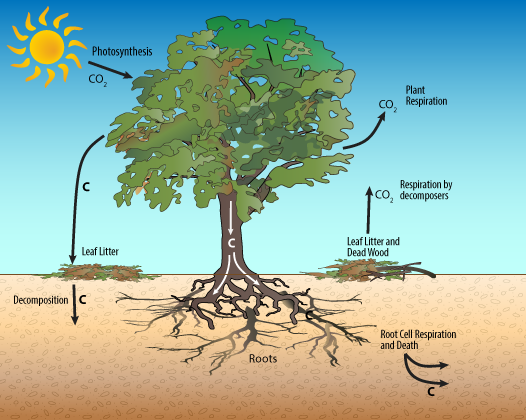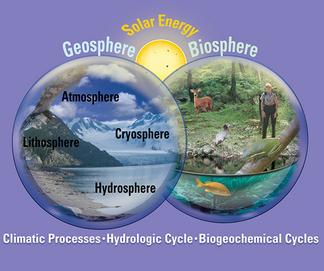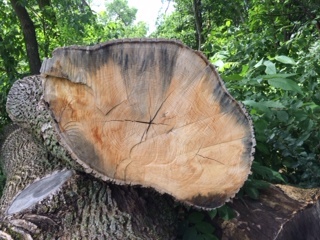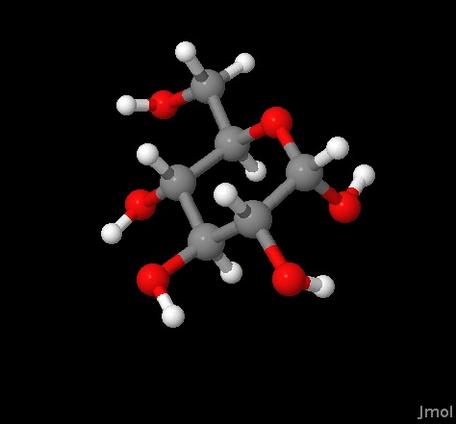-
Lab 1: Living in a Carbon World
Lab 1: Living in a Carbon World
Introduction:
In the non-living environment, we find carbon compounds in the atmosphere, carbonate rocks, and fossil fuels such as coal, oil and gasoline.
In the living environment, carbon atoms form the structural molecular backbone of the important molecules of life: proteins, carbohydrates, lipids and nucleic acids (in addition to other carbon compounds made by living organisms).
Carbon is a versatile element; it can exist in very small 2-atom molecules such as carbon monoxide (CO) up to molecules that contain thousands of atoms such as proteins and DNA.
On Earth, carbon compounds circulate through land, the atmosphere, oceans and all the organisms that live there. All of these components comprise the global carbon cycle. As carbon compounds circulate, they are continually converted into new forms of carbon compounds. Biosphere organisms from the largest tree to the smallest microbe have key roles in converting carbon compounds into new forms and in cycling carbon throughout the global carbon cycle.
the Geosphere carbon cycle and the Biosphere carbon cycle. The Geosphere carbon cycle operates at very long, slow time scales of thousands to millions of years. Sedimentation, lithification, tectonics and volcanism are important Geosphere processes that convert carbon compounds into new forms.
The Biosphere carbon cycle operates on time scales of seconds up to hundreds of years. Photosynthesis, respiration and combustion are key Biosphere processes that convert carbon compounds into new forms.
PART A:
You will trace the pathway of carbon from the atmosphere into trees where carbon can be stored for hundreds to thousands of years.
You will trace the pathway of carbon from the atmosphere into trees where carbon can be stored for hundreds to thousands of years.
Living in a Carbon World
Part A: Trees - The Carbon Storage Experts
Have you ever stood next to a tree and wondered how this tree got to be so big? In California, some Giant Sequoia trees are more than 2000 years old and grow to be over 300 feet tall. General Sherman pictured in the image on the right, is the largest tree in the world by volume and is estimated to weigh over a million kilograms of mass (2,204,622 pounds).
Where does all that mass come from?
Where does all that mass come from?
Think about the question above as you watch scientists taking measurements of The President, the second largest giant sequoia in this National Geographic Video 'Magnificent Giant Tree: Sequoia in a Snowstorm.'
Discuss
With a partner, write down ideas of where you think the mass of the Giant Sequoia tree comes from as it grows and then create a class list of all possible ideas.
Discuss
Compare and discuss people's hypotheses from the video with your class's ideas about where the mass of a tree comes from.
- Which items on both lists are misconceptions about how a tree grows and adds mass.
- Where does a tree actually get most of its mass from?
Trees use the carbon from carbon dioxide to make sugar molecules
Plants use organic carbon compounds for energy, growth and metabolism. Examine the images of glucose and cellulose pictured below. Then, answer the checking in questions below. NOTE: Carbon atoms are grey, hydrogen atoms are white and oxygen atoms are red. Click on the images for a larger view.

Checking In
Carbon atoms cycle throughout the Geosphere and Biosphere as part of millions of different types of carbon compounds
The amount of CO2 trees absorb from air influences climate
Like all plants, trees are an important component of the Earth System biosphere primarily because they absorb so much carbon dioxide from the atmosphere and store the carbon in their biomass. As a greenhouse gas(GHG), carbon dioxide (CO2) plays an important role in regulating Earth's climate. By reducing the amount of atmospheric CO2, trees have the capacity to influence climate.
The amount of carbon stored in biomass depends on the balance of carbon input via photosynthesis and carbon output via respiration
There are three important carbon cycle processes that cycle carbon compounds into and out of trees, and into storage in biomass:
- Photosynthesis is the carbon cycle process that moves carbon atoms from the air into trees and all other plants. Carbon atoms move into the biosphere and into most food webs via this process.
- Respiration is the key carbon cycle process that moves carbon atoms out of plants into the atmosphere, surrounding soil or water.
 Carbon Cycle of a Single Tree. Credit: Valerie Martin, TERC
Carbon Cycle of a Single Tree. Credit: Valerie Martin, TERC
 Carbon Cycle of a Single Tree. Credit: Valerie Martin, TERC
Carbon Cycle of a Single Tree. Credit: Valerie Martin, TERC- Examine the diagram of the carbon cycle of a single tree, pictured on the right.
- Take a few minutes to trace where the carbon goes. When you are finished, answer the Checking In questions below.
Checking In
Stop and Think
1: Using the tree diagram above to help you, explain why trees (and all plants) represent a small but complete carbon cycle. Draw your own diagram to help you illustrate your answer.
- PART B, you will go outdoors and measure the amount of carbon in a local tree.
Part B: Carbon Storage in Local Trees
Adapted from Janowiak, M.: "The Carbon in Trees" activity from Future Fuels from Forests Teacher Institute. 2009, Northern Institute of Applied Science , Michigan Technological University.
You may have a favorite tree nearby in your own backyard, outside your school or in your neighborhood. How much carbon do you think this tree stores? You can easily determine the amount of carbon stored in your favorite tree using simple materials and calculations.
First, watch forest ecologist Laura Marx describe carbon storage in a Red Oak tree in a Massachusetts forest.
As you watch, write down three facts about carbon storage in trees you think it is important to share with the class before you begin this activity.
First, watch forest ecologist Laura Marx describe carbon storage in a Red Oak tree in a Massachusetts forest.
As you watch, write down three facts about carbon storage in trees you think it is important to share with the class before you begin this activity.
Discuss
As a class, share and discuss the three facts you wrote down about carbon storage in trees. Then, dicuss the following question:Lab investigation: How Much Carbon is Stored in a Local Tree?
In this activity, you will determine the amount of carbon stored in a local tree. You will develop a set of skills that you can use on many species of trees, from urban trees to trees in the middle of forests. These skills include:- Identifying species names and common names of trees.
- Measuring and determining a tree's diameter.
- Calculating a tree's biomass.
- Using allometry and allometric cooefficients to calculate mass of carbon stored in a tree.
- Calculating the approximate mass of CO2 taken in by your tree to build its carbon store.
- Watch this Vimeo video on how to measure trunk diameter before going outside to select a nearby tree to study. Make note of important instructions. If the video doesn't play, watch here: Trunk Diameter: Learn To Measure on Vimeo
- Select a local tree with a circumference of at least 38 cm (15 inches), if possible. Assign your tree a number. NOTE: Each tree should have a different number.
- Identify the species and common name of the tree using a tree guide .
- (NOTE:You will need to choose a species of tree whose common name is on the table of Allometric Coefficients for Common North American Trees(Microsoft Word 2007 (.docx) 91kB Jan30 15)
- Take a picture and/or make drawings of the tree. You may want to include other information such as environmental variables that might impact the growth of the tree (for example, soil type, soil moisture, soil nutrients , amount of light the tree gets, temperature etc.)
- Is this species a hardwood or softwood? The resources you used to help identify your tree species should tell you if your tree is a hardwood or softwood. If not, use this resource Hardwood or Softwood?
- Determine the diameter (cm) of the tree trunk at 1.4 meters (4.5-4.6 feet) from the ground. Use one of the two following methods:
- Use a diameter tape measure to directly measure diameter. Convert to centimeters (cm) if necessary.
- Use a regular tape measure or string to measure the circumference of the tree. Convert the circumference measurement to centimeters(cm) if necessary. Divide the circumference(cm) measurement by 3.14(Pi) to calculate the diameter.
- Calculate the biomass (M) for your tree. To calculate tree biomass, foresters use a standard allometric equation M=aDb where: M= above ground dry weight biomass(kg) of the treeD= diameter measured at 1.4 meters above ground"a" and "b" are species-specific allometric coefficients. Locate these two coefficients for the common name of your tree on the Allometric Coefficients for Common North American Trees(Microsoft Word 2007 (.docx) 91kB Jan30 15)table.
- Calculate the approximate mass of carbon atoms stored in your tree in kilograms(kg). . A tree's biomass contains carbon atoms in addition to hydrogen, oxygen nitrogen, phosphorus and sulfur atoms. Foresters know that approximately half of a tree's biomass is made of carbon atoms. This value is slightly different in hardwood vs softwood trees. To determine the amount of carbon in your species of tree, choose one of the following:Multiply tree biomass (M) by 0.521 for hardwood trees =____(kg) of carbon storedMultiply tree biomass (M) by 0.498 for softwood trees = _____(kg) of carbon storedCalculate the approximate amount of CO2 your tree absorbed via photosynthesis to create its stored mass of carbon. NOTE: Not all CO2 a tree takes in gets stored as mass. Some returns to the air via respiration.
- Scientists have determined that 1 kg of carbon is equivalent to approximately 3.67 kg of CO2. Thus, multiplying the carbon stored (kg) in your tree by 3.67 will give you an approximate measure of CO2 taken in via photosynthesis and stored in the tree.
Checking In
How many kg of CO2 did your single local tree remove from the atmosphere and store in its biomass? - (Optional) Convert the mass of carbon stored in your tree to metric tons. NOTE: Scientists normally use metric tons to quantify carbon storage. Do a simple calculation using this conversion factor (1 metric ton = 1000 kg) or use the worldwide metric calculator.
Discuss
As a class, discuss the following:- After graphing is completed, analyze and discuss the graphs in terms of the following:
- interesting patterns that emerge from the data(if any)
- amount of carbon stored (sequestered)
- amount of CO2removed from the atmosphere by the trees and stored in tree biomass.
- What environmental variables, if any, could influence the amount of carbon stored by trees. How?
- How might tree carbon storage data and your new skills be useful to your community?
Stop and Think
1: Carbon dioxide (CO2) is a greenhouse gas that naturally warms the atmosphere as part of the greenhouse effect. Unfortunately, the amount of CO2 in the atmosphere has been increasing over the past hundred years. According to scientists, this increase in atmospheric CO2 has caused the average global temperature on Earth to increase by about 0.8° Celsius since 1880. Two-thirds of the warming has occurred since 1975, at a rate of roughly 0.15-0.20°C per decade. (NASA)
- Explain how planting and growing more trees could mitigate this warming trend in global temperature.

![[creative commons]](https://serc.carleton.edu/images/creativecommons_16.png)






No comments:
Post a Comment